Centipedes come in a variety of colours. Some of the most unusual are those that exhibit bright, eye-catching colours, such as those with blue legs.
Contents
What is a centipede?
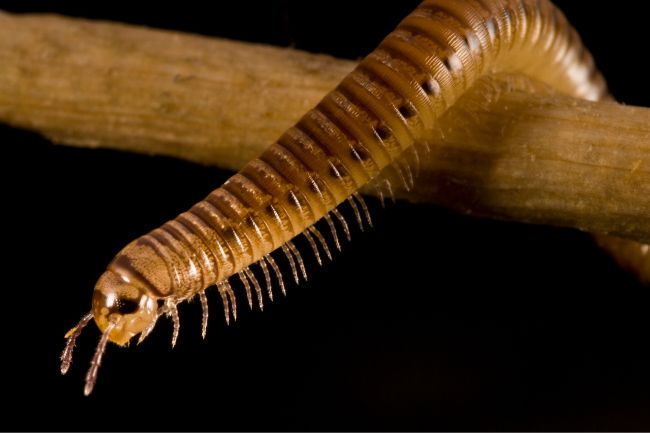
Centipedes are a group of arthropods with elongated bodies and one leg per body segment. This means that they can have between 15 and 177 pairs of legs, despite their name meaning 100 legs.
Centipedes are often confused with millipedes, which have two legs per body segment. As well as morphological differences, the two groups also have vastly different lifecycles, with millipedes being largely detritivores, eating dead wood and other plant matter. Centipedes by comparison are ferocious hunters, who feed on insects, amphibians and even small rodents in the case of some of the larger species.
In order to help them do this, they have a set of venomous claws at the front of their body, and adapted legs they can use to inject venom into their prey. This can be extremely painful, even for larger animals such as humans.
There are around 3,000 centipedes across the world, though it is thought roughly 8,000 may exist. They are found on all continents aside from Antarctica and have adapted to live in a wide range of habitats, from rainforests to deserts.
Also read: Centipedes Have 100 Legs: Myth or a Reality (Let’s Explore)
Why are some centipedes red?
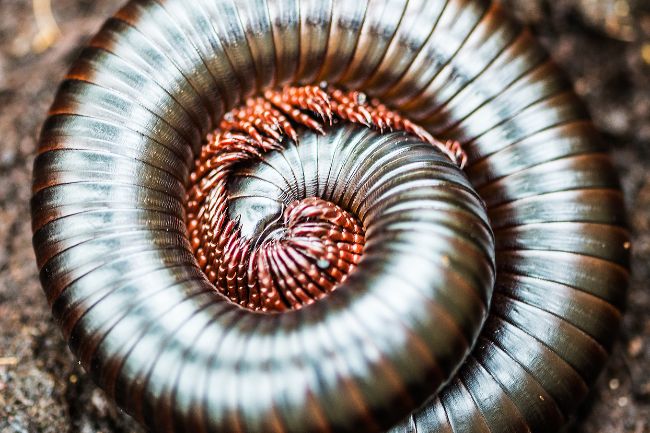
Many arthropods, such as insects, practice what is known as ‘warning colouration’. This is where they display bright colours and striking patterns to tell predators that they are equipped with some kind of defence. This may be a poison that the animal will ingest if they eat them, or it may be the fact they have fangs or a stinger.
While centipedes may not appear to be dangerous from the outside, many of them have venomous claws, with which they can cause a seriously painful nip. Not all centipedes decide to declare this, however, perhaps because they themselves are hunters, and they would instead remain camouflaged so as better to ambush their prey.
It may be that those most likely to opt for warning colouration are those that are more visible to larger predators, such as centipede species that spend more time in the open.
Also read: Here’s How Big Millipedes Are – Around the World
Centipedes with red legs
Vietnam Giant Red Legs Centipede (Scolopendra dehaani)
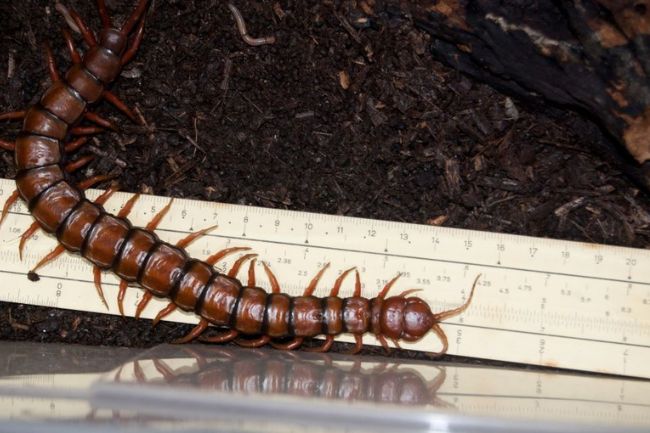
Growing up to 20cm (7.87in) in length, this centipede is one of the larger global species. Known to be particularly aggressive, with an unpleasant bite, it’s definitely a species to steer clear of. Like many centipedes, it can come in a variety of colour morphs, with the main body varying from brown, to yellow to red. Legs too can vary in colour, however, some individuals have bright red legs.
This species is found across much of Southeast Asia and is often called different names to reflect this. Their strong venom means that it can be very unpleasant to be bitten by this species. Pets are similarly likely to find the sting very painful, though it is unlikely to result in death.
Also read: A List of Centipedes that are Poisonous to our Pets
Red Head Tiger Leg Centipede (Scolopendra morsitans)
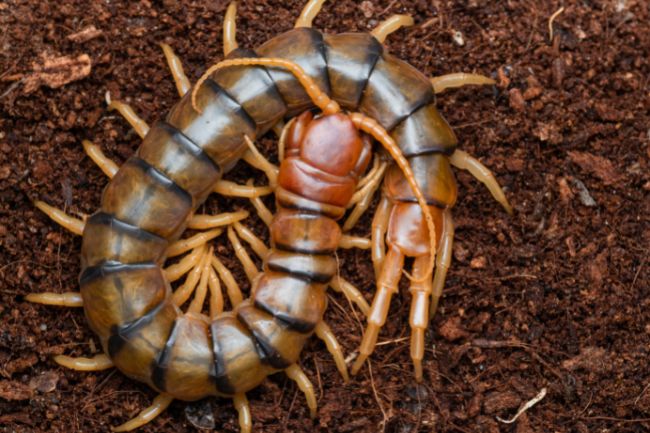
This species is highly variable in colour, with species ranging from yellows, to oranges to hints of blue, as well as those with red legs. Its name stems from the darker rings down the length of its body and its often red head.
Having been moved around the globe by humans, today it is found on every continent aside from the Antarctic. It is an aggressive species, with a venom that can be painful to humans, though reactions are generally not serious.
Indian tiger centipede (Scolopendra hardwicki)
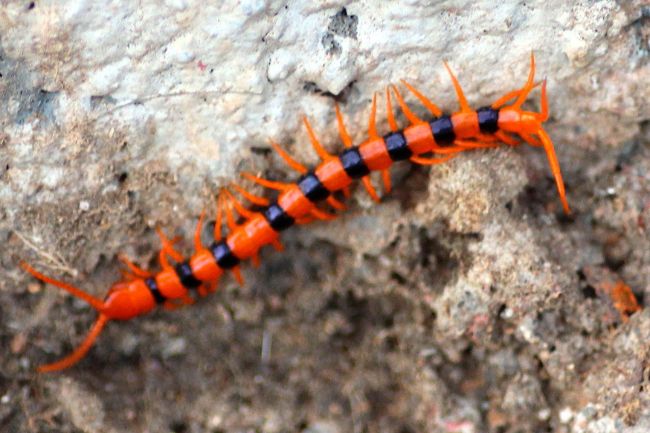
Found across the south of India as well as occasionally in Sumatra and Nikobar, the Indian tiger centipede is a striking species, with thick black bands across an orangey-red body, with orangey-red legs.
This unusual patterning gives it its name as the Indian tiger centipede, and may be to warn its predators that it is dangerous to attack. Around 16cm (6.29in) in length, its painful bite has been shown to cause drowsiness. Pets may also experience a similar discomfort when bitten.
Chinese Giant Tiger Leg Centipede (Scolopendra hainanum)
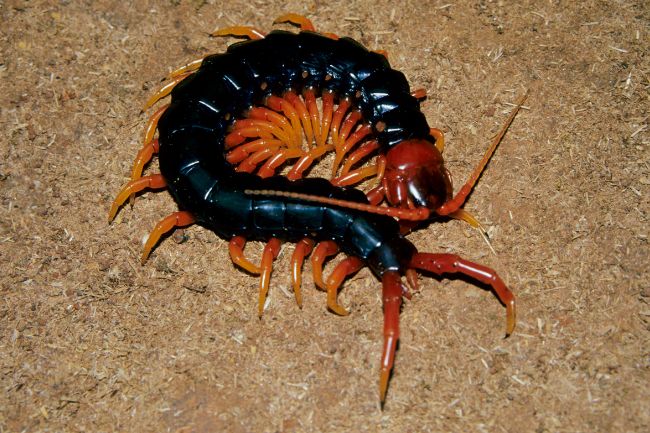
Found in China, the Chinese giant tiger leg centipede certainly has a mouthful of a name. However, when you see its distinctly striped legs, you can understand why. With a dark brown body, this species can grow up to 20cm (7.87in) in length.
Leg colour can vary, with some species having paler yellow stripes, while in some they are more of an orangey red colour. Stings from this species can cause nausea and headaches, as well as localised pain. Pets are also likely to experience similar symptoms if bitten.
Also read: Centipedes Life Span: How Long do They Live?
Other centipede species with red legs
| Centipede Species | Body Length | Number of Legs | Red Leg Coloration | Habitat Preference |
|---|---|---|---|---|
| Red-legged Centipede | 6-8 inches | 30+ | Bright red legs | Tropical and subtropical regions |
| Red-headed Centipede | 2-3 inches | 30+ | Red legs with black bands | Forests, leaf litter |
| Red-striped Centipede | 3-4 inches | 30+ | Red legs with stripes | Moist environments |
| Red-footed Centipede | 4-6 inches | 30+ | Red legs with dark spots | Tropical rainforests |
Eye-catching centipede
In nature, red is a very common warning colour, often telling potential predators that their prey carries a nasty toxin. This is certainly the case with our red-legged centipedes, who often carry a nasty venom that no hungry critter would like to encounter.
Still, even with their bright and colourful warning signals, as long as we let them go about their business undisturbed, they really have no need to utilise their weapons of war on us.

